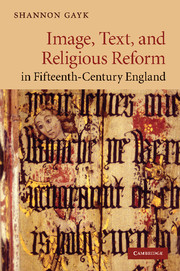Book contents
- Frontmatter
- Contents
- Acknowledgements
- List of abbreviations
- Introduction: reformations of the image
- 1 Lollard iconographies
- 2 Thomas Hoccleve's spectacles
- 3 John Lydgate's refigurations of the image
- 4 John Capgrave's material memorials
- 5 Reginald Pecock's libri laicorum
- Epilogue: words for images
- Notes
- Bibliography
- Index
- CAMBRIDGE STUDIES IN MEDIEVAL LITERATURE
3 - John Lydgate's refigurations of the image
Published online by Cambridge University Press: 17 November 2010
- Frontmatter
- Contents
- Acknowledgements
- List of abbreviations
- Introduction: reformations of the image
- 1 Lollard iconographies
- 2 Thomas Hoccleve's spectacles
- 3 John Lydgate's refigurations of the image
- 4 John Capgrave's material memorials
- 5 Reginald Pecock's libri laicorum
- Epilogue: words for images
- Notes
- Bibliography
- Index
- CAMBRIDGE STUDIES IN MEDIEVAL LITERATURE
Summary
The substance, the means of art, is an incarnation; not reference, but phenomena.
Denise LevertovJohn Lydgate has often been cast as the poster child of fifteenth-century orthodoxy. He represents, in Derek Pearsall's influential words, “the pattern of the new orthodoxy” – an orthodoxy characterized by relentless moralizing and political and ecclesiological kowtowing. Or so the critical story goes. There is, of course, some truth to this account. However, in this chapter I want to suggest that Lydgate's intervention in the image debates is as much (if not more) representative of a new orthopraxis than of a “new orthodoxy.” After all, the controversy surrounding religious images is always as much bound up with practice as it is with doctrine, as bound up with how people use images as what they believe about them. Much like Hoccleve, Lydgate is interested in modes of apprehending the material world. But rather than employ vernacular verse to lament the limits of visual certitude, Lydgate crafts poems that instruct the viewer in how to read images. In so doing, he models a literary practice that is reformist and generative, that inscribes the objects and practices of contemporary devotion within an increasingly textual culture.
Lydgate's interest in material culture is well documented, his commitment to exploring the relationship between images and texts less so. However, Lydgate is clearly committed to working in the murky representational borderlands, both by translating material objects into vernacular texts and by theorizing the relative values of the two modes of representation.
- Type
- Chapter
- Information
- Publisher: Cambridge University PressPrint publication year: 2010



